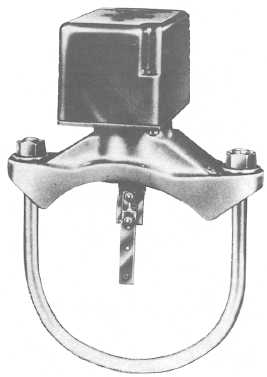valve (alarm check or swing check) that holds excess pressure on the system side of the check valve. These detectors are frequently used where a water surge or hammer causes false alarms with other types of water-flow detectors. The construction of pressure drop detectors is similar to the pressure increase detectors. The switch for a pressure drop detector is arranged to actuate on a drop in pressure.
There is no retarding mechanism or chamber. A typical switch of this type would be adjusted for a normal operating pressure in the range of 50 to 130 psi. The alarm pressure would be adjustable between 10 to 20 psi below normal pressure. A vane type of water-flow detector (fig. 8-22) is used only in wet pipe sprinkler systems. The detector is assembled at the pipe by drilling a hole in the wall of the sprinkler pipe, inserting the vane into the pipe, then clamping the detector on with U-bolts. When the sprinkler system is actuated by fire, the water flowing through the pipe causes the

Figure 8-22. - Vane type of water-flow detector.
vane to move. A mechanical linkage connects the vane to an adjustable retarding device, usually a pneumatic dashpot. The retarding device actuates the alarm switch or switches and/or signal transmitter. The retarding device setting is usually in the range of 30 to 45 seconds. A maximum setting may be as high as 90 seconds if necessary.
The pressure pump/pressure drop type of water-flow detector is used in large sprinkler systems and in those systems with inadequate water pressure to reliably operate one of the other types of water-flow detectors. These detectors are also known as fixed-pressure, water-flow detectors, with pump (fig. 8-23). This detector has a pump, pump motor, and control unit. It is arranged for strap-mounting to the sprinkler system riser. The device provides a water-flow alarm signal, a low system water pressure supervisory signal, and excess pressure in the system to prevent surges in the supply pressure from opening the alarm check valve and causing operation of the water motor gong or other alarm indicators.
A typical detector of this type is adjusted to maintain the system pressure at 25 to 50 psi above supply pressure. A slow leak at the alarm check valve or anywhere in the system will cause the system pressure to drop slowly. When pressure decreases to 2 psi below the preset value, a pressure switch closes, causing the pump to start pumping water from the supply side to the system side of the alarm check valve at a rate of about 1 gallon per minute (gpm). If the total system leaks less than 1 gpm, the pressure switch opens and stops the pump when the preset pressure is reached. However, if the system leaks are greater than 1 gpm, system pressure will continue to drop even with the pump running. If system pressure decreases to 4 psi below the preset value, a trouble pressure switch opens to indicate that there is a leak greater than 1 gpm. If the water pressure continues to drop to 6 psi below the preset value, an alarm pressure switch closes, signaling a water- flow alarm. Some water-flow detectors of this type have an additional switch that disconnects pump power when the supply water pressure drops below 14 psi. This prevents pump burnup in case of total supply shutdown or a break in the supply line.
Continue Reading